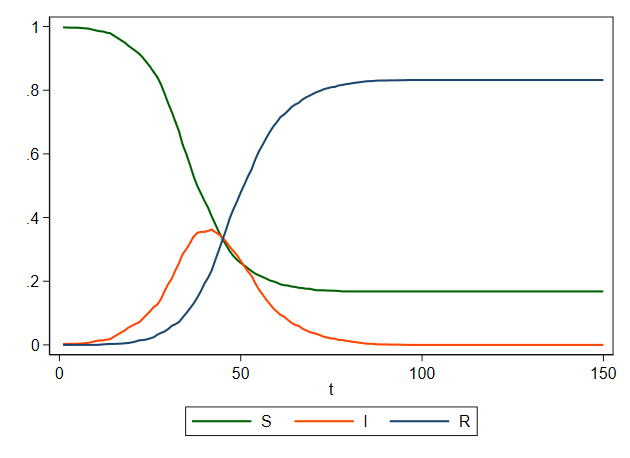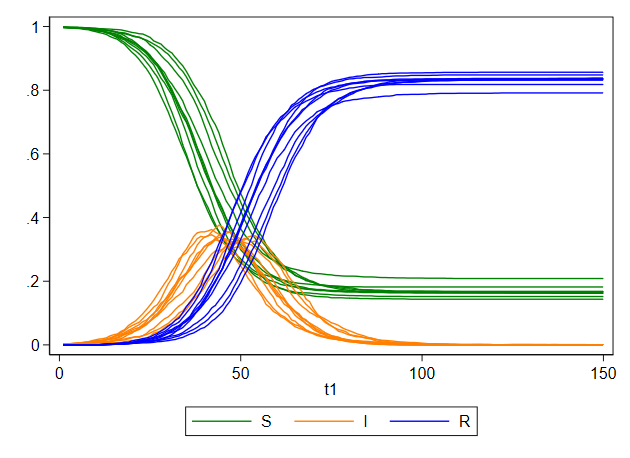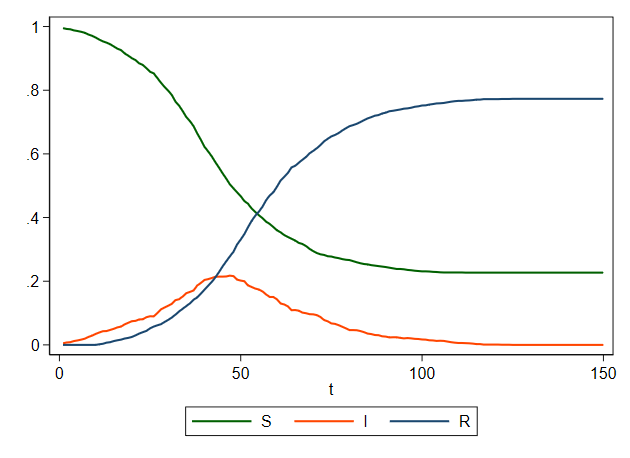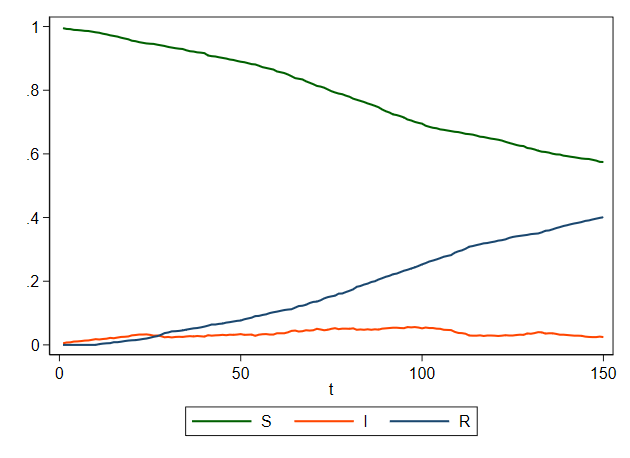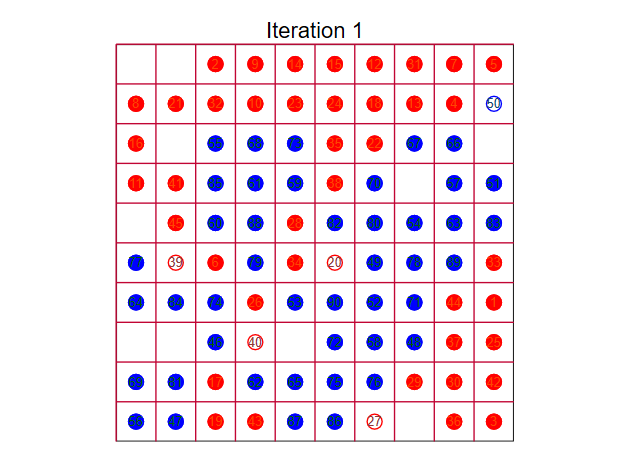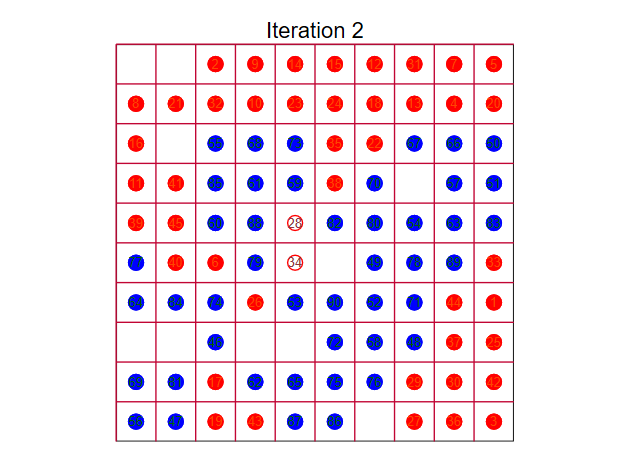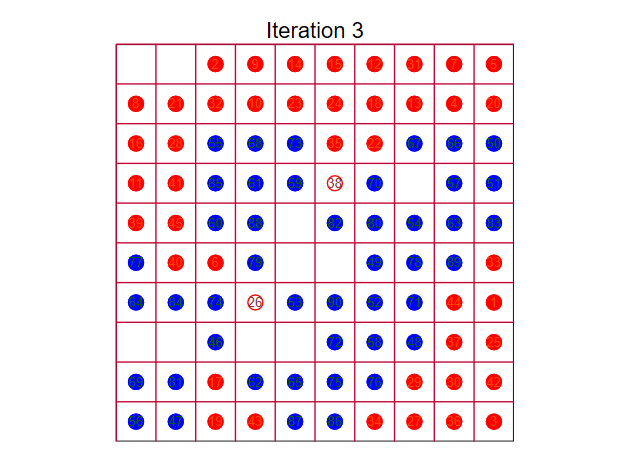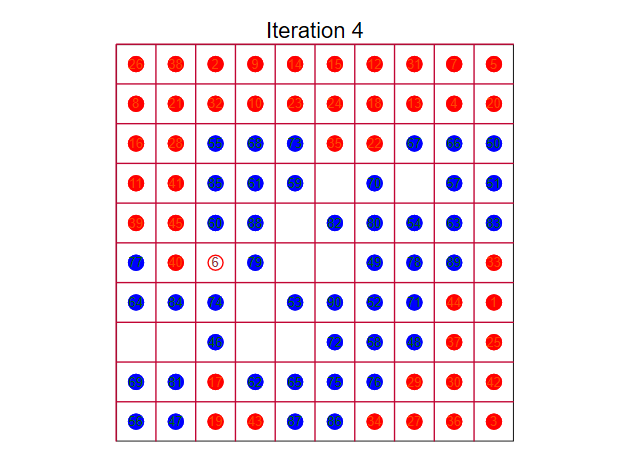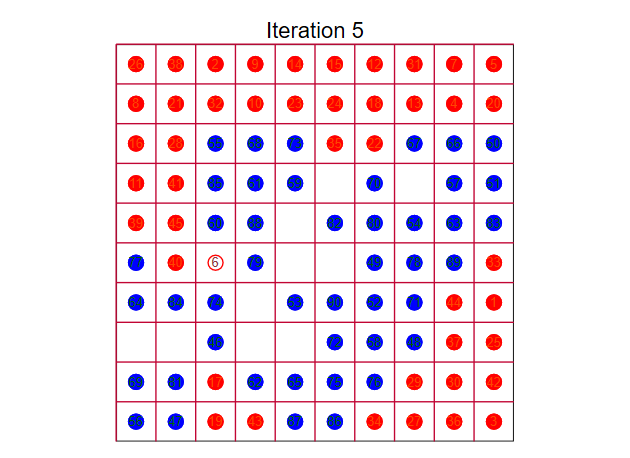-------------------------------------------------------------------------------
How to implement an ABM in Mata
-------------------------------------------------------------------------------
Basic SIR model
Lets take a look at the code for the basic SIR model:
version 16.1
run abm_pop.mata
mata:
mata set matastrict on
class sir {
class abm_pop scalar agents
real scalar tdim
real scalar outbreak
real scalar removed
real scalar mcontacts
real scalar N
real scalar transmissibility
real scalar mindur
real scalar meandur
real scalar pr_heal
real scalar pr_loss
// sir_chks.do
void posint()
void pr()
void isid()
void istime()
// sir_set_pars.do
transmorphic N()
transmorphic tdim()
transmorphic outbreak()
transmorphic removed()
transmorphic mcontacts()
transmorphic transmissibility()
transmorphic mindur()
transmorphic meandur()
transmorphic pr_loss()
// sir_sim.do
void setup()
real matrix meet()
real scalar infect()
void progress()
void step()
void run()
void dots()
// sir_export.do
void export_sir()
void export_r()
}
end
do sir_chks.do
do sir_set_pars.do
do sir_sim.do
do sir_export.do
exit
The model is implemented as a >> class
The population is stored is stored in another class abm_pop, which is
available from https://github.com/maartenteaches/abm_pop.
Whatever is stored in abm_pop is assumed to persist until you store
something else. So you only have to store the disease state of an agent
when it changes. This can save a lot of reading and writing and make the
simulation run quicker.
There are various checks perfomed and we can see those
include sir_locals.do
mata:
void sir::posint(real scalar val)
{
if (val <= 0 | val != ceil(val)) {
_error("argument must be a positive integer")
}
}
void sir::pr(real scalar val)
{
if (val <0 | val > 1) {
_error("argument must be between 0 and 1")
}
}
void sir::isid(real scalar id)
{
if (id < 0 | id > N | id!=ceil(id)) {
_error("argument is not a valid id")
}
}
void sir::istime(real scalar t)
{
if (t<0 | t > tdim | t!=ceil(t)) {
_error("argument is not a valid time")
}
}
end
The functions that set the parameters are shown
include sir_locals.do
mata:
transmorphic sir::N(| real scalar val)
{
if (args() == 1) {
posint(val)
N = val
}
else {
return(N)
}
}
transmorphic sir::tdim(| real scalar val)
{
if (args() == 1) {
posint(val)
tdim= val
}
else {
return(tdim)
}
}
transmorphic sir::outbreak(| real scalar val)
{
if (args() == 1) {
posint(val)
outbreak= val
}
else {
return(outbreak)
}
}
transmorphic sir::removed(| real scalar val)
{
if (args() == 1) {
posint(val)
removed= val
}
else {
return(removed)
}
}
transmorphic sir::mcontacts(| real scalar val)
{
if ( args()==1 ) {
if ( val < 0) _error("arguments must be positive")
mcontacts = val
}
else {
return(mcontacts)
}
}
transmorphic sir::transmissibility(| real scalar val)
{
if ( args()==1 ) {
pr(val)
transmissibility = val
}
else {
return(transmissibility)
}
}
transmorphic sir::mindur(| real scalar val)
{
if ( args()==1 ) {
posint(val)
mindur = val
}
else {
return(mindur)
}
}
transmorphic sir::meandur(| real scalar val)
{
if ( args()==1 ) {
if (val < 0) _error("argument must be positive")
meandur = val
}
else {
return(meandur)
}
}
transmorphic sir::pr_loss(| real scalar val)
{
if ( args()==1 ) {
pr(val)
pr_loss = val
}
else {
return(pr_loss)
}
}
end
The main simulation functions are
include sir_locals.do
mata:
void sir::run()
{
real scalar i, t
setup()
dots(0)
dots(1)
for (t=2; t<=tdim; t++) {
dots(t)
for(i=1; i<=N ; i++) {
step(i,t)
}
}
}
void sir::setup()
{
real vector id, key
real scalar i
if (N==.) _error("N has not been set")
if (tdim==.) _error("tdim has not been set")
if (outbreak==.) _error("outbreak has not been set")
if (outbreak > N) _error("the initial outbreak is larger than population")
if (removed==.) removed = 0
if (removed + outbreak > N) _error("intial outbreak + removed agents is larger than the population")
if (mcontacts==.) _error("mcontacts has not been set")
if (mcontacts > N) _error("average number of mcontacts is larger than population")
if (transmissibility==.) _error("transmissibility has not been set")
if (mindur==.) _error("mindur has not been specified")
if (meandur==.) _error("meandur has not been specified")
if (meandur <= mindur) _error("meandur must be larger than mindur")
if (pr_loss==.) pr_loss = 0
agents.N(N)
agents.k(3)
agents.setup()
id = jumble((1..N)')
for (i = 1; i<= N; i++) {
key = id[i],`state',1
agents.put(key,(i<=outbreak ? `infectious' : (i <= outbreak+removed ? `removed' : `susceptible')))
key[2] = `exposes'
if (i <= outbreak) agents.put(key, J(2,0,.) )
key[2] = `dur'
agents.put(key,1)
}
// if meandur - mindur < 1 then pr_heal > 1, so there is no randomness to the duration
// and the fixed duration of the disease is mindur
pr_heal = 1/(meandur-mindur)
}
void sir::step(real scalar id, real scalar t)
{
real matrix exposed
real scalar i, k
real rowvector key
isid(id)
istime(t)
key = id, `dur',t
agents.put(key, agents.get(key, "last")+1)
progress(id,t)
key = id, `state',t
if (agents.get(key, "last") == `infectious' ) {
exposed = meet(id, t)
for(i=1; i<= cols(exposed); i++) {
exposed[2,i] = infect(exposed[1,i],t)
}
key[2] = `exposes'
agents.put(key,exposed)
}
}
void sir::progress(real scalar id, real scalar t)
{
real rowvector key1, key2, key3
isid(id)
istime(t)
key1 = id, `state',t
key2 = id, `dur',t
if (agents.get(key1, "last") == `infectious' & agents.get(key2, "last") > mindur) {
if (runiform(1,1) < pr_heal) {
agents.put(key1, `removed')
agents.put(key2,1)
key3 = id, `exposes',t
agents.put(key3,NULL)
}
}
if (agents.get(key1, "last") == `removed' & runiform(1,1) < pr_loss) {
agents.put(key1, `susceptible')
agents.put(key2,1)
}
}
real matrix sir::meet(real scalar id, real scalar t)
{
real scalar k
real colvector res
real rowvector key
isid(id)
k = rpoisson(1,1,mcontacts)
if (k == 0) {
return(J(2,0,.))
}
else{
res = ceil(runiform(1,k):*(N-1))
res = res + (res:>=id)
res = res \ J(1,k,.)
return (res)
}
}
real scalar sir::infect(real scalar id, real scalar t)
{
real vector key
real scalar infected
isid(id)
istime(t)
infected = 0
key = id,`state', t
if (agents.get(key, "last")==`susceptible') {
if (runiform(1,1) < transmissibility) {
agents.put(key, `infectious')
key[2] = `dur'
agents.put(key, 1)
key[2] = `exposes'
agents.put(key,J(2,0,.))
infected = 1
}
}
return(infected)
}
void sir::dots(real scalar t)
{
if (t==0) {
printf("----+--- 1 ---+--- 2 ---+--- 3 ---+--- 4 ---+--- 5\n")
}
else if (mod(t, 50) == 0) {
printf(". %9.0f\n", t)
}
else {
printf(".")
}
displayflush()
}
end
The "variables" in agents are actually numbered and not named. To make it
easier to read the code I use local macros defined in
// address in abm_pop class agents
local state = 1
local dur = 2
local exposes = 3
// states
local susceptible = 1
local infectious = 2
local removed = 3
The functions that allow you to export the results to Stata are
include sir_locals.do
mata:
void sir::export_sir(| string rowvector names)
{
real matrix res
pointer matrix p
string rowvector varnames
real scalar xid, n, i, j
if (args() == 1) {
if (cols(names)!= 4) _error("4 variable names need to be specified")
varnames = names
}
else {
varnames = "t", "S", "I", "R"
}
res = J(N,tdim,.)
p = agents.extract(`state', tdim)
for (i=1; i<=N; i++) {
for(j=1; j<=tdim; j++) {
res[i,j] = *p[i,j]
}
}
res = (1..tdim)', mean(res:==`susceptible')',
mean(res:==`infectious')',
mean(res:==`removed')'
xid = st_addvar("float", varnames)
n = st_nobs()
n = rows(res) - n
if (n > 0) {
st_addobs(n)
}
st_store(.,xid, res)
}
void sir::export_r()
{
real matrix res
pointer matrix p_exposes, p_state
real scalar xid, n, i, j, t
string rowvector varnames
real colvector n_ill
t = .
res = (1..tdim)',J(tdim,1,0)
n_ill = J(tdim,1,0)
p_exposes = agents.extract(`exposes',tdim)
p_state = agents.extract(`state',tdim)
for (i=1; i<=N; i++) {
if (*p_state[i,1]==`infectious') {
t=1
}
else {
t=.
}
for(j=2;j<=tdim;j++) {
if (*p_state[i,j-1]==`susceptible' &
*p_state[i,j] ==`infectious') {
t=j
n_ill[t] = n_ill[t] + 1
}
if (*p_state[i,j-1]==`infectious' &
(*p_state[i,j] ==`removed' | *p_state[i,j] ==`susceptible')) t = .
if (t!=.) {
res[t,2] = res[t,2] + rowsum((*p_exposes[i,j])[2,.])
}
}
}
res[.,2] = res[.,2]:/n_ill
varnames = "t", "reprod"
xid = st_addvar("float", varnames)
n = st_nobs()
n = rows(res) - n
if (n > 0) {
st_addobs(n)
}
st_store(.,xid, res)
}
end
-------------------------------------------------------------------------------
<< index >>
-------------------------------------------------------------------------------
-------------------------------------------------------------------------------
How to implement an ABM in Mata
-------------------------------------------------------------------------------
SIR model in a network
To add the network we make use the abm_nw class, which is available from
https://github.com/maartenteaches/abm_nw.
This takes care of creating the network and keeps track of who can
contact who.
With that the changes required are fairly small
The class definition is
version 16.1
run abm_pop.mata
run abm_nw.mata // <-- new
mata:
mata set matastrict on
class sir_nw {
class abm_pop scalar agents
class abm_nw scalar nw // <-- new
real scalar tdim
real scalar outbreak
real scalar removed
// real scalar mcontacts // <-- no longer necessary
real scalar N
real scalar transmissibility
real scalar mindur
real scalar meandur
real scalar pr_heal
real scalar pr_loss
real scalar degree // <-- new
real scalar pr_long // <-- new
// sir_chks.do
void posint()
void pr()
void isid()
void istime()
// sir_set_pars.do
transmorphic N()
transmorphic tdim()
transmorphic outbreak()
transmorphic removed()
// transmorphic mcontacts() // <-- no longer necessary
transmorphic transmissibility()
transmorphic mindur()
transmorphic meandur()
transmorphic pr_loss()
transmorphic degree() // <-- new
transmorphic pr_long() // <-- new
// sir_sim.do
void setup()
// real matrix meet() // <-- no longer necessary
real scalar infect()
void progress()
void step()
void run()
void dots()
// sir_export.do
void export_sir()
void export_r()
void export_nw() // <-- new
}
end
do nw_chks.do
do nw_set_pars.do
do nw_sim.do
do nw_export.do
exit
Checks and setting parameters are pretty much the same
The main simulation functions are
include nw_locals.do
mata:
void sir_nw::run()
{
real scalar i, t
setup()
dots(0)
dots(1)
for (t=2; t<=tdim; t++) {
dots(t)
for(i=1; i<=N ; i++) {
step(i,t)
}
}
}
void sir_nw::setup()
{
real vector id, key
real scalar i
if (N==.) _error("N has not been set")
if (tdim==.) _error("tdim has not been set")
if (outbreak==.) _error("outbreak has not been set")
if (outbreak > N) _error("the initial outbreak is larger than population")
if (removed==.) removed = 0
if (removed + outbreak > N) _error("intial outbreak + removed agents is larger than the population")
if (transmissibility==.) _error("transmissibility has not been set")
if (mindur==.) _error("mindur has not been specified")
if (meandur==.) _error("meandur has not been specified")
if (meandur <= mindur) _error("meandur must be larger than mindur")
if (pr_loss==.) pr_loss = 0
if (degree==.) _error("degree has not been specified") // <-- new
if (pr_long==.) _error("pr_long has not been specified") // <-- new
nw.clear() // <-- new
nw.N_nodes(0,N) // <-- new
nw.directed(0) // <-- new
nw.tdim(0) // <-- new
nw.sw(degree,pr_long) // <-- new
nw.setup() // <-- new
agents.N(N)
agents.k(4)
agents.setup()
id = jumble((1..N)')
for (i = 1; i<= N; i++) {
key = id[i],`state',1
agents.put(key,(i<=outbreak ? `infectious' : (i <= outbreak+removed ? `removed' : `susceptible')))
key[2] = `exposes'
if (i <= outbreak) agents.put(key, J(2,0,.) )
key[2] = `dur'
agents.put(key,1)
}
// if meandur - mindur < 1 then pr_heal > 1, so there is no randomness to the duration
// and the fixed duration of the disease is mindur
pr_heal = 1/(meandur-mindur)
}
void sir_nw::step(real scalar id, real scalar t)
{
real matrix exposed
real scalar i, k
real rowvector key
isid(id)
istime(t)
key = id, `dur',t
agents.put(key, agents.get(key, "last")+1)
progress(id,t)
key = id, `state',t
if (agents.get(key, "last") == `infectious' ) {
exposed = nw.neighbours(id) // <-- new
exposed = exposed \ J(1,cols(exposed),.) // <-- new
for(i=1; i<= cols(exposed); i++) {
exposed[2,i] = infect(exposed[1,i],t)
}
key[2] = `exposes'
agents.put(key,exposed)
}
}
void sir_nw::progress(real scalar id, real scalar t)
{
real rowvector key1, key2, key3
isid(id)
istime(t)
key1 = id, `state',t
key2 = id, `dur',t
if (agents.get(key1, "last") == `infectious' & agents.get(key2, "last") > mindur) {
if (runiform(1,1) < pr_heal) {
agents.put(key1, `removed')
agents.put(key2,1)
key3 = id, `exposes',t
//agents.put(key3,NULL)
}
}
if (agents.get(key1, "last") == `removed' & runiform(1,1) < pr_loss) {
agents.put(key1, `susceptible')
agents.put(key2,1)
}
}
real scalar sir_nw::infect(real scalar id, real scalar t)
{
real vector key
real scalar infected
isid(id)
istime(t)
infected = 0
key = id,`state', t
if (agents.get(key, "last")==`susceptible') {
if (runiform(1,1) < transmissibility) {
agents.put(key, `infectious')
key[2] = `dur'
agents.put(key, 1)
key[2] = `exposes'
agents.put(key,J(2,0,.))
infected = 1
}
}
return(infected)
}
void sir_nw::dots(real scalar t)
{
if (t==0) {
printf("----+--- 1 ---+--- 2 ---+--- 3 ---+--- 4 ---+--- 5\n")
}
else if (mod(t, 50) == 0) {
printf(". %9.0f\n", t)
}
else {
printf(".")
}
displayflush()
}
end
-------------------------------------------------------------------------------
<< index >>
-------------------------------------------------------------------------------
-------------------------------------------------------------------------------
ancillary
-------------------------------------------------------------------------------
Other Scenarios
Recently, there have an increasing number of news stories about that
immunity against COVID-19 does not persist
We can change to model to see how that impacts the spread of the disease
. clear mata
. drop _all
. run sir_main.do
.
. mata:
------------------------------------------------- mata (type end to exit) -----
:
: model = sir()
: model.N(2000)
: model.tdim(250)
: model.outbreak(5)
: model.mcontacts(4)
: model.transmissibility(0.045)
: model.mindur(10)
: model.meandur(14)
: model.pr_loss(0.02)
: model.run()
----+--- 1 ---+--- 2 ---+--- 3 ---+--- 4 ---+--- 5
.................................................. 50
.................................................. 100
.................................................. 150
.................................................. 200
.................................................. 250
: model.export_sir()
: end
-------------------------------------------------------------------------------
.
. twoway line S I R t, name(anc1, replace) ///
> ylabel(,angle(0)) legend(rows(1)) lwidth(*1.5 ..)
. drop _all
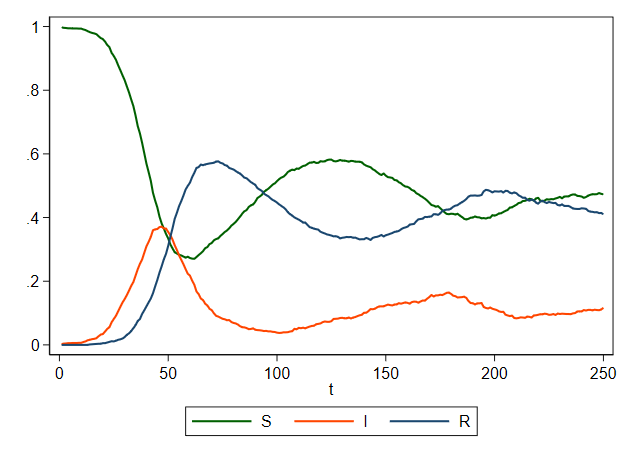
Similarly, we can study the potential impact of policies encouraging
social distancing or the wearing of masks by changing the
transmissibility
. mata:
------------------------------------------------- mata (type end to exit) -----
: model.pr_loss(0)
: model.tdim(150)
: model.transmissibility(0.03)
: model.run()
----+--- 1 ---+--- 2 ---+--- 3 ---+--- 4 ---+--- 5
.................................................. 50
.................................................. 100
.................................................. 150
: model.export_sir()
: end
-------------------------------------------------------------------------------
.
. twoway line S I R t, name(anc2, replace) ///
> ylabel(,angle(0)) legend(rows(1)) lwidth(*1.5 ..)
. drop _all
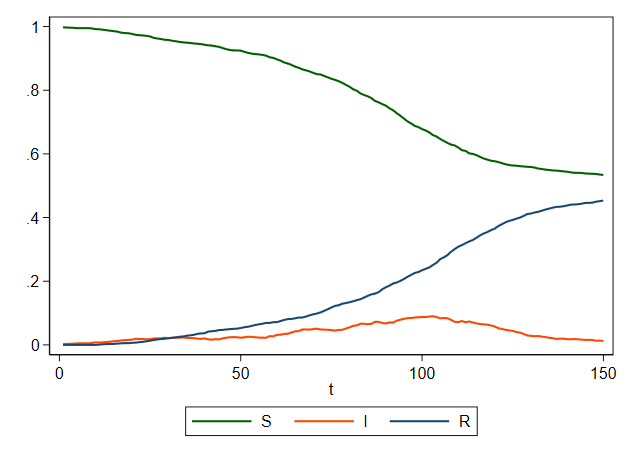
or the potential impact of a lockdown, which would influence the number
of people someone is in contact with
. mata:
------------------------------------------------- mata (type end to exit) -----
: model.transmissibility(0.045)
: model.mcontacts(3)
: model.run()
----+--- 1 ---+--- 2 ---+--- 3 ---+--- 4 ---+--- 5
.................................................. 50
.................................................. 100
.................................................. 150
: model.export_sir()
: end
-------------------------------------------------------------------------------
.
. twoway line S I R t, name(anc3, replace) ///
> ylabel(,angle(0)) legend(rows(1)) lwidth(*1.5 ..)
. drop _all
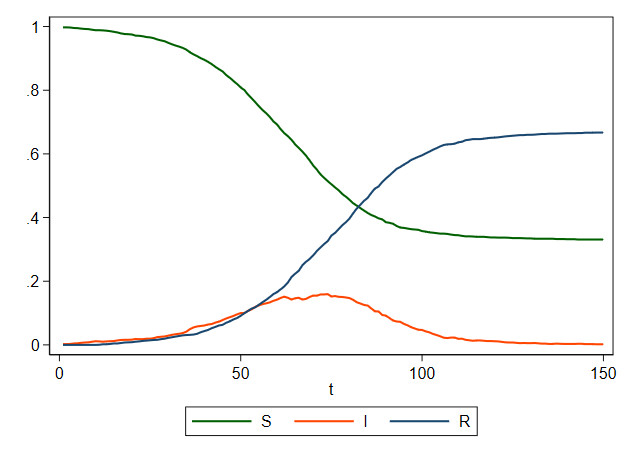
-------------------------------------------------------------------------------
index
-------------------------------------------------------------------------------
